#verse; academy era/time period
Explore tagged Tumblr posts
Text
my fav frerard fics
Ok so here’s my grank fic rec list!! I’ve put links to each fic on ao3 for easy access + most if not all have nsfw/explicit elements so be warned!! I’ve written afew tags next to each one so u get an idea but no spoilers ok here we gooo
⭐️ = fav of all time/must read
- The Best Part of My Day by pixie_revolver - office co-workers au
- ⭐️pinkish by antspaul - kid fic, fake relationship to lovers
- Black Market Blood by autoschediastic - short vamp!gee/human!frank
- ⭐️The Mess We've Made by ViciousVenin - pencey era frank, strangers to lovers, angst with happy ending
- Life as a Process by ViciousVenin - fav vamp!gee fic, college roommates au
- Happy Together by MorningGloryxxx - focus on mental health/lgbt themes/addiction, eventual happy ending
- A Splitting Of The Mind by Shoved2agree - yall already know, cw for heavy mental health focus
- Unwanted Thoughts by ViciousVenin - touring, pining, friends to lovers
- Skin of the Canvas by sinsense - art school/nude model au
- ⭐️Unholyverse trilogy by Bexless - holy grail of fics, priest!gee, demons, stigmata (you've probably already read this ik)
- ⭐️The Anatomy of a Fall by novembersmith - supernatural, high school au
- ''that was easy'' by metaleaterz - 'the staples fic', they just work at staples and its cute ok
- another superstition by metaleaterz - friends to lovers houseflipping au
- ⭐️Crossed Out by Haze - time travel and blood magic!! so incredible it should be made into a tv show umbrella academy style
- ⭐️In a Column of Lights by xobarriers - entomologist!gee/director!frank, SO wholesome and sweet and lovely
- Did You Miss Me? Cause I Missed You by LiberXI - wholesome/funny/smutty friends to lovers college au
- ⭐️Nothing Above Nothing Below by LiberXI - pencey era strangers to lovers with a supernatural twist, LOVE the writing style sm
- You Will Leave a Mark by brooklinegirl - short but intense pencey era strangers to lovers
- rough ‘round the edges by starryfrens - sick fic with gee as frank’s caregiver, heavy and heartwarming
- Living on a prayer by beforethesungoesdown, Kitoko_kun - priest x priest with expected amounts of catholic guilt and pining
- Before The Second Show by CharredLips - sweet + fluffy bullets era mutual pining
- ⭐️Wishing You Were a Ghost by pixie_revolver - “right person wrong time”, angst with happy ending, heartbreaking but amazing
- ⭐️Kinktober 2023 by insusurro - all parts set in the same universe, surprisingly heartwarming for the subject matter, great characterisation
- ⭐️Moth to Flame (or Whatever) by onceuponamoon - insanely perfect florist au
- Companion by onceuponamoon - workplace au (carer/office worker)
- Buy Handmade + Bread and Butter by jjtaylor - adorable artist/baker au
- ⭐️Paris!Verse trilogy by vesna - artist gerard/record label owner frank, INSANELY good characterisation, so beautiful and emotional
- Time Travel ‘verse by ladyfoxxx - funpoison/frankghoul/rrr time travel shenanigans, amazing and kind of heartbreaking
- Christmas Miracle by insusurro - wholesome and festive teacher au
- Choosing My Confessions series by pixie_revolver - kinky/wholesome priest au
- a constant record of disillusion by drapnel - non au realistic pre-bullets to post-summer sonic ‘04, heavy so read tags
- All Through The Night by LiberXI - bullets era meet cute
- ⭐️The Horror That I’m In by pixie_revolver - paramour estate, paranormal activity, frank goes through the horrors, angst with happy ending
updating periodically so keep an eye out <3
#frerard#grank#fic rec#mcr fic#fan fiction#remember when this was an art blog? me neither#gerard way#frank iero#mcr
227 notes
·
View notes
Text
Jean Maurice Eugène Clément Cocteau, was a French poet, novelist, filmmaker, designer, playwright, actor, and theater director.
Cocteau began writing at the age of ten and at sixteen he published his first poems, a year after leaving the family home. Despite distinguishing himself in virtually every literary and artistic field, Cocteau insisted that he was fundamentally a poet and that all of his work was poetry.
In 1908, at the age of nineteen, he published his first book of poetry, La lampe d'Aladin. His second book, Le prince frivole ("The frivolous prince"), published the following year, would give rise to the nickname he had in Bohemian circles and in the artistic circles that he began to frequent and in which he quickly became known.
Around this time he met the writers Marcel Proust, André Gide, and Maurice Barrès. Edith Wharton described him as a man "to whom every great verse was a sunrise, every sunset the foundation for the Celestial City..."
During the First World War, Cocteau served with the Red Cross as an ambulance driver. During this period he met the poet Guillaume Apollinaire, the painters Pablo Picasso and Amedeo Modigliani and numerous other writers and artists with whom he would later collaborate.
Russian ballet impresario Sergei Diaghilev challenged Cocteau to write a scenario for a new ballet - "It surprises me", Diaghilev was quoted as saying. The result was Parade, which would be produced by Diaghilev in 1917, with scenography by Picasso and music by Erik Satie. (Maisons-Lafitte, July 5, 1889 — Milly-la-Forêt, October 11, 1963)
Together with other Surrealists of his generation (Jean Anouilh and René Char, for example), Cocteau managed to masterfully combine the new and old verbal codes, staging language and technologies of modernism to create a paradox: a classic avant-garde. His circle of associates, friends and lovers included Jean Marais, Henri Bernstein, Édith Piaf and Raymond Radiguet.
His plays were taken to the stages of the Grand Theatres, on the Boulevards of the Parisian era in which he lived and which he helped define and create. His versatile, unconventional approach and enormous productivity brought him international fame.
He was elected member of the French Academy in 1955.
Cocteau made seven films and collaborated as a screenwriter and narrator in a few more. All rich in symbolism and surreal images. He is considered one of the most important filmmakers of all time.
#edisonmariotti @edisonblog
.br
Jean Maurice Eugène Clément Cocteau, foi um poeta, romancista, cineasta, designer, dramaturgo, ator, e encenador de teatro francês.
Cocteau começou a escrever aos dez anos e aos dezasseis já publicava suas primeiras poesias, um ano depois de abandonar a casa familiar. Apesar de se distinguir em virtualmente todos os campos literários e artísticos, Cocteau insistia que era fundamentalmente um poeta e que toda a sua obra era poesia.
Em 1908, com dezanove anos, publicou o seu primeiro livro de poesia, La lampe d'Aladin. O seu segundo livro, Le prince frivole ("O princípe frívolo")), editado no ano seguinte, daria origem à alcunha que tinha nos meios Boémios e nos círculos artísticos que começou a frequentar e em que rapidamente ficou conhecido.
Por esta altura conheceu os escritores Marcel Proust, André Gide, e Maurice Barrès. Edith Wharton descreveu-o como um homem "para quem todos os grandes versos eram um nascer-do-sol, todos os por-do-sol a fundação para a Cidade Celestial…"
Durante a Primeira Guerra Mundial, Cocteau prestou serviço na Cruz Vermelha como condutor de ambulâncias. Neste período conheceu o poeta Guillaume Apollinaire, os pintores Pablo Picasso e Amedeo Modigliani e numerosos outros escritores e artistas com quem mais tarde viria a colaborar.
O empresário russo de ballet, Sergei Diaghilev, desafiou Cocteau a escrever um cenário para um novo bailado - "Surpreende-me", teria dito Diaghilev. O resultado foi Parade, que seria produzido por Diaghilev em 1917, com cenografia de Picasso e música de Erik Satie. (Maisons-Lafitte, 5 de julho de 1889 — Milly-la-Forêt, 11 de outubro de 1963)
Em conjunto com outros Surrealistas da sua geração (Jean Anouilh e René Char, por exemplo), Cocteau conseguiu conjugar com mestria os novos e velhos códigos verbais, linguagem de encenação e tecnologias do modernismo para criar um paradoxo: um avant-garde clássico. O seu círculo de associados, amigos e amantes incluiu Jean Marais, Henri Bernstein, Édith Piaf e Raymond Radiguet.
As suas peças foram levadas aos palcos dos Grandes Teatros, nos Boulevards da época parisiense em que ele viveu e que ajudou a definir e criar. A sua abordagem versátil e nada convencional e a sua enorme produtividade trouxeram-lhe fama internacional.
Foi eleito membro da Academia Francesa em 1955.
Cocteau realizou sete filmes e colaborou enquanto argumentista, narrador em mais alguns. Todos ricos em simbolismos e imagens surreais. É considerado um dos mais importantes cineastas de todos os tempos.
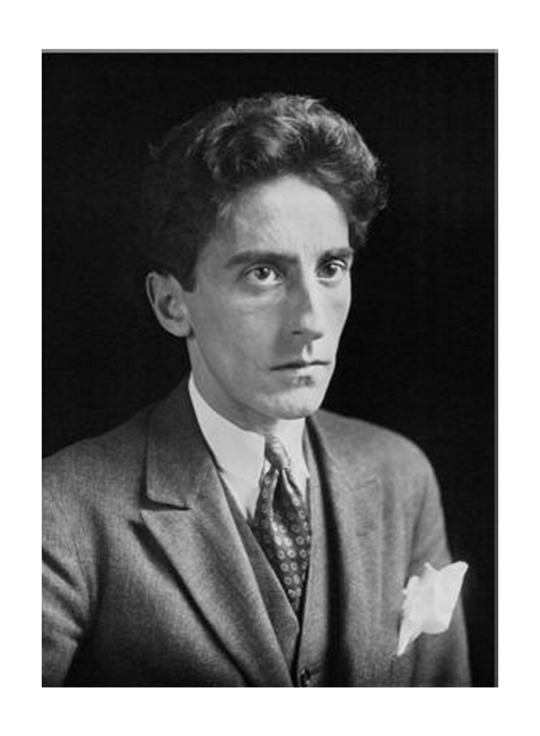
3 notes
·
View notes
Note
Happy Mother’s Day, what was Dancing-Hands, Arnoss, Nyrhen, Farell and Vaalin mothers like?
Mother's day isn't for another few weeks.
-Dancing-Hands's mother was, in her younger years, an imperial guard as they were investigating the Kami rifts during the Era of Enlightenment with the Jukai's help. After the creation of the Merge gates, she married a kitsune of the Jukai she had worked with, who later became Dancing-Hands' father. She was the one to initially introduce Dancing-Hands to origami, but their relationship didn't fare too well along the years. His parents had very little authority on Dancing-Hands come his forties, and she regrets what happened to him. They've met again since and she knows he's alive, but it's been tough to rebuild things.
-Arnoss didn't have a singular "mother", that's not how the Family's typically raises children, he was under the care of all the adult Beldruns. As far as biological parents, he's never met his mother (at least he doesn't think so), his egg was bought from another family that couldn't support any more Ghavaleks. This is also not uncommon in the Family between caravans that trust each other.
-Nyrhen's mother was incredibly proud of her boy, even if he didn't do anything particularly glamorous or important. He was always Perfect to her eyes. Also she was a Lorwyn elf, so, y'know, the baggage that comes with that. Weapon-carver, some of which were deemed worthy of being used by Perfects.
-Farell's mom is Lady Leana Javori, born Bassola. She's cunning, positive, and confident. She's well-versed in politics and etiquette. She uses them as she needs to, but isn't fond of what comes with it, so she sometimes ignores convention when she thinks they're wrong.
Her birth name is an old, powerful and respected one on Fiora, and she very much married under her station when she did a newly ennobled merchant and had to give up her name for his when she did. She further mudded her name by carrying to term a bastard child from a shapeshifter who tricked her, and giving him her birth name. Despite the events of that night, she loves Farell just as much as she does her human children. She encouraged Farell into finding his own way, to be proud and keep his head high. The aristocracy may see him as lesser, but it's their loss if they underestimate her eldest son.
-Vaalin's mother was killed during the current phyrexian invasion, so he's still processing that, especially considering he had to keep working after learning of her death, alone in his head for long periods of time. She was a Vodalian merfolk from the Volshe caste, a mathematician, who had briefly studied at Tolaria (of the Depths). She joined a diplomatic mission to the surface world and met Vaalin's father, a human, there. She laid Vaalin's egg not too long after coming back from that year-long expedition. Knowing the xenophobic caste system underlying Vodalian society would be very harsh on a half-human, she sought refuge for her and her child in Tolaria's waters, where minds were more progressive.
There, she raised her child by herself within the Academy's reach, trying her best to shield him from the disdain and hatred that inevitably filtered through even in the school. Most students at Tolaria of the Depths have vodalian origins and culture after all, be it recent or older. She had her concerns when he specialized in temporal studies and might have tried to push him towards more practical studies. His achievements of the past few years on Dominaria and other worlds had placated her doubts though.
#fanwalker#mtg#Mother's Day#Wrong date though#Farell#Arnoss#Dancing-Hands#Nyrhen#Vaalin#fanwalker asks
7 notes
·
View notes
Text
Women Talking (2022)
Sarah Polley is one of those auteurs whose filmography plays out like a student learning their craft. Her feature film debut “Away From Her” was simplistic in its narrative, then came her autobiographical documentary “Stories We Tell” where her storytelling improved. Now we have “Women Talking” which is Polley coming into a milieu of character development and emotional strife. With the Academy Awards only a few hours away from the writing of this post, Polley will surely be dusting off space on her shelf for her well deserved Oscar.

From Miriam Toews’ novel of the same name, “Women Talking” focuses on a small group of women and girls in a Hutterite colony in Canada. Abuse has been rampant for a long time and things have hit a breaking point with the arrest of some of the colony’s most powerful elders. With charges pending, a meeting of some of the victims takes place in which a decision must be made. Will they stay behind and forgive their abusers, which would mean a place in heaven? Or will they desert the only home they ever know and risk eternal damnation? Over the course of 24 hours, that choice is debated back and forth.
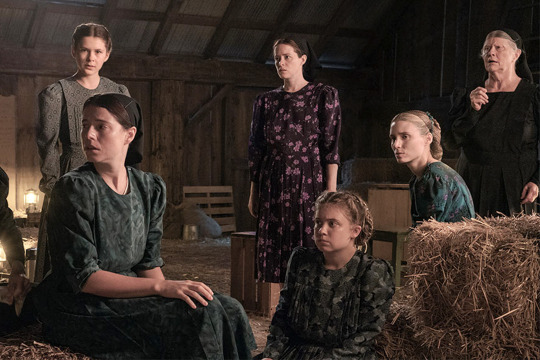
The only thing contemporary about “Women Talking” is the year that the story takes place; 2010. Beyond that, this is as much a period piece as any classic novel from the 19th century adapted by Merchant-Ivory or David Lean. The characters’ fashion, speech, demeanor and movement all harken back to a long ago era, despite the year and their insulation from the outside world is also odd. Just like the Amish in Pennsylvania or Hasidic Jews in parts of Brooklyn, the past is the present, and the present is non-existent. The choice to photograph in semi-black and white was also wise as if to illustrate the purgatory that each woman lives through on a daily basis, but also the fact that they live in another universe that happens to be on Earth. Even the film score by Oscar winner Hildur Guðnadóttir has the feel of a Sci-fi epic, but with a more Classical slant. It may have taken place in recent years and brings up now-current issues such as #MeToo, but “Women Talking” couldn’t be more of an anomaly in so many categories, and that winds up being the film’s greatest strength.

“Women Talking” starts very deceptively as a Brecht style drama in which dialogue is spoken more in verse format and there’s very little emotion from each character. Words repeat nonstop and you wonder what the nucleus of the film really is. But that is the entire point, these women are conditioned to act as common folk, knowing very little about things that the majority of humanity take for granted, like maps and grammatical punctuation. Brecht’s work can be seen as dry poetic legalese, that stagnates the environment around its characters. But then gradually, the dialogue becomes more free-flowing, the sentences much looser in pronunciation and the cries much more melodic, rather than pent up and the colors even become a little brighter. As you see the characters evolve, so do their surroundings.

One of the drawbacks about a film’s ensemble is that there are no truly standout performances, but rather little standout scenes. The cast spans from veterans like Judith Ivey, Frances McDormand and Sheila McCarthy to the newer crop of actresses like Claire Foy, Rooney Mara and Jessie Buckley. All of them are equally amazing and do their own acting exercises which illuminates the drama. Ivey is the one that has the most heart tugging scenes. Being the eldest of the group, her character Agata knows only the few acres of land as her world, but its her strength that makes her see beyond familiarity. Foy’s Salome is another character whose hurt and injury is all over her face and voice. Buckley’s Mariche is probably the most delicate of the women, precious like a porcelain doll, but fragile like cracked glass. The problem is, not enough time is given to really let us know these women individually, as opposed to as the collective that are presented as. That is not the fault of the screenplay, but the plot’s setting and circumstances. That being said, I would have liked to at least see one or two characters up close as a sample of what life in the colony was like instead of brief flashbacks that give off a superficial experience.
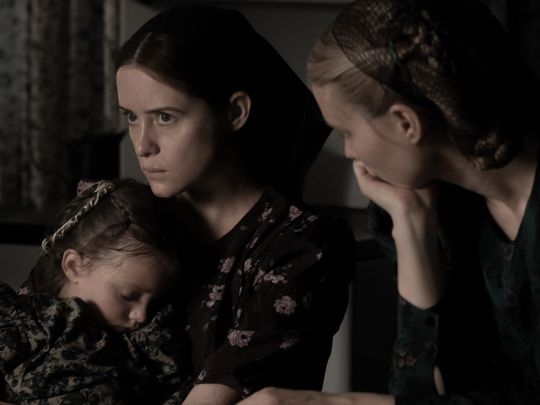
After tonight’s Oscar ceremony, whether or not Sarah Polley wins the Oscar for Best Adapted Screenplay, she will be a major player in Hollywood and I hope she takes advantage of it well. “Women Talking” may not be perfect, but it’s the calling card for a fruitful career that I hope will be rich in future masterpieces.
8/10
#dannyreviews#women talking#sarah polley#miriam toews#hildur guðnadóttir#judith ivey#frances mcdormand#sheila mccarthy#claire foy#rooney mara#jessie buckley#metoo#academy awards#oscars#hutterites#canada
11 notes
·
View notes
Text
Don't give up 'Cause you have friends Don't give up You're not beaten yet Don't give up I know you can make it good
With So, Peter Gabriel put aside his dogged experimentation to craft a set of emotional eloquent, musically exquisite songs that shine as brightly as they did in 1987. Luckily for us today, this includes 'Don't Give Up', an enduring classic that understands human weaknesses, but also understand our strengths, becoming more beautiful for it.
Peter Gabriel is among the most respected and lauded men in music, beloved by listeners and admired by his peers. Originally the contentious leader of prog-to-pop legends Genesis, Gabriel left the band in the mid-70s, frustrated by his bandmates' contrary musical directions (they did alright without him, to say the least). Embarking on a solo career, Gabriel produced 4 self-titled albums (given fan nicknames like Melt or Car), attempting to balance his own musical curiosities with accessible songwriting, but not always successfully. As much as I like barbershop quartets, you only really need to hear 'Excuse Me' once.
When he does nail it though, it can be magnificent. Even before So, PG I-IV have scattered gems throughout, such as 'Here Comes the Flood', 'Biko' and 'San Jacinto', with subjects ranging from the relief of personal freedom, to existential anxieties, to solidarity with anti-colonial struggles. In terms of music, Gabriel can just bash out a good anthemic number, while simultaneously drawing from experimental techniques and so-called 'world music'. Thankfully, he gives the music styles and traditions outside of the Euro-American scope more respect than recording academies, working with several musicians from the global south in his career, and highlighting them in their own right through his Real World Records label and studio. But let's get back to the So era.
Initially inspired by an American Depression-era photograph by Dorothea Lange, the lyrics certainly convey some period allusions, invoking the struggles of rural working class families migrating to large urban centres in search of desperate chances. That said, the song is free of overly specific detail, to its, and our, benefit. The verses are desolate with crushing reality, while the choruses, performed by the esteemed Kate Bush, uplift with reassuring comfort and resolve in a wonderfully atmospheric question and answer. 'Don't Give Up' is as direct a sentiment as Gabriel can muster, much needed in the late 80s, and unfortunately, as much needed now. This sentiment is capped with the memorable music video, with Bush and Gabriel standing alone together, him clutching in need of strength, and her embracing back with unconditional warmth and support. It'd be impossible to count how many have drawn stability from this song, becoming able to take another step the next day (this number famously includes Elton John, who credits the track with inspiring him to get sober).
It's hard to know what to do in times like this, when every effort seems for nothing, and adversaries feel untouchable. It is essential though to observe how others fight, both around you and beyond your reach. Look at how others resist the same obstacles you face. Look at how those elsewhere face horrors you can barely conceive of, yet resist anyway. You are capable of this too, and there are many ways to stand against that which would destroy you, and in solidarity with people who you will never meet, but share a struggle with.
Don't give up.
Tuesday Night Music Club No. 48 - 'Don't Give Up' by Peter Gabriel & Kate Bush
youtube
#I love you.#Even if we never speak I am on your side.#A better world is always possible.#Please remember this.
1 note
·
View note
Note
"Who did this?" Avery demanded, holding up a picture of Kyosta's busted lip to Crissy. "I want names." The usually gentle girl's eyes were fierce, shifting quickly like a kaleidoscope between shades of green and copper-brown. ~@only-somewhat-visible

“Avery, honeybun, sweetheart, relax.” Crissy commanded, taking a gulp of her tea. “It was my fault. We were sparring and he moved his head at the wrong time so my fist connected with his lip instead of his cheek. That’s all.” She set her cup down and placed her hands on the curve of Avery’s shoulders.
“Honey, the only people who can take Kyosta on and injury him, are me and Stonnick. And the only reason why, is because we know him so well. I’ve known Ky since he was born. His movements and the way he thinks is as familiar to me as my own. Ok?” She ducked down slightly to look Avery in the eye. “You off the war path now? Or do you want to smack me?”
7 notes
·
View notes
Text
10 characters who won’t show up on Strange New Worlds
so, I keep saying that if Strange New Worlds had been all new characters, I would enjoy it more. I stand by that assessment, but since they set it when they did, with whom they did, I really hope that they would make use of what we know about that timeframe and some of the connections these characters have. This is my wishlist, though I’m not expecting any of them to actually show up.

10. Lorca Prime - Prime!verse counterpart of the Mirror!verse captain on DIS
We never found out what happened to him, so what if Mirror!Lorca just locked him in a box somewhere and Enterprise finds him in SNW? Bonus points if Pike and Lorca were boyfriends at Academy and Pike didn’t understand what happened when he heard what Lorca did on Discovery, and made it his mission to find out, which is why he knows about Mirrorverse when no one else should.
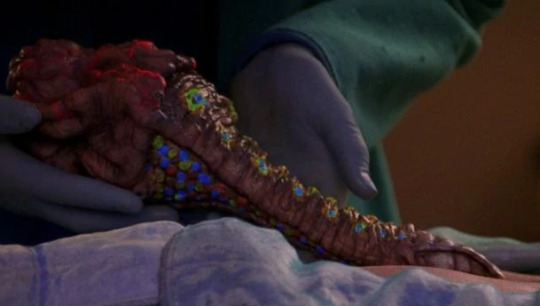
9. Lela Dax - first host of the Dax symbiont, who was part of two major characters in DS9
While honestly I just want more Jadzia in my life, it would be amazing to get some more canon for her (and Ezri) to explain her past lives.
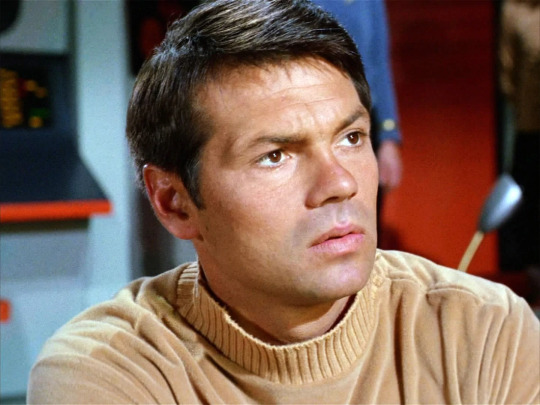
8. Gary Mitchell - an officer in one ep of TOS who was apparently a good friend of Kirk’s
Although Gary Mitchell was in only one episode of Star Trek, he has an outsized role in fanfic as Kirk’s past boyfriend, and/or best friend, and/or Starfleet villain. Is he really the misogynist asshole the little we see of him pre-ESP-boost implies? Or can he be redeemed?
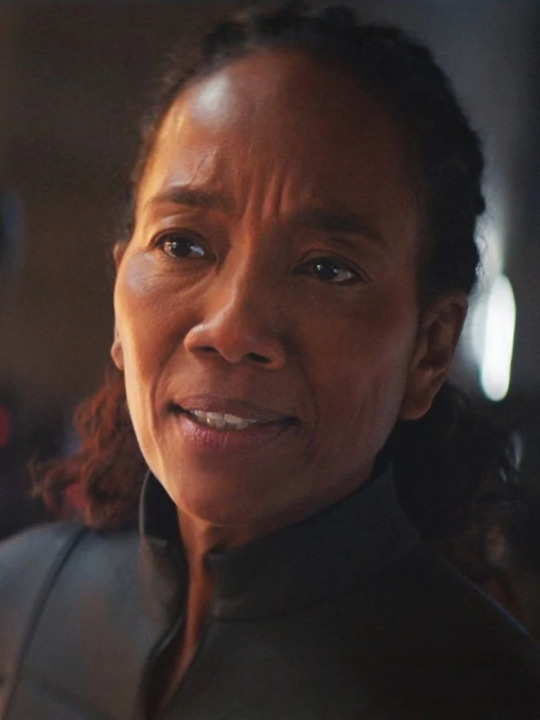
7. Gabrielle Burnham - mother of Michael Burnham, main character in DIS
Okay, technically, the crew of SNW exists in a time and reality in which Michael theoretically succeeded in taking Discovery 930 years into the future. If that is the case, Gabrielle actually can’t show up in SNW era time and reality. If she had time jumped back in time to the year SNW is in now, it would be into a reality in which Michael had not succeeded . . . right? I don’t know, but I’m interested in solving this time paradox if it means I get to look at Sonja Sohn some more.
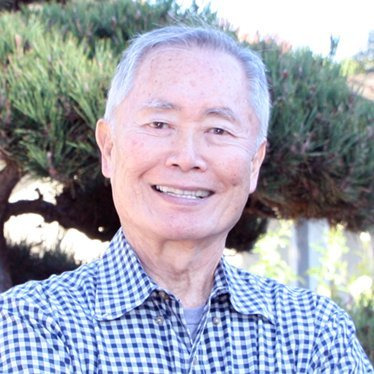
6. Admiral Sulu - early 3000s Sulu time traveling back to his early years
Okay, so I lied. This is not a list of people from the time period that Star Trek should take advantage of. It’s just a list of cool people I want to see. But why can’t Sulu have some time travel adventures late in life? I would pay to see them, personally, and would enjoy it much more than if they choose to cast yet another Sulu and introduce them to the bridge.
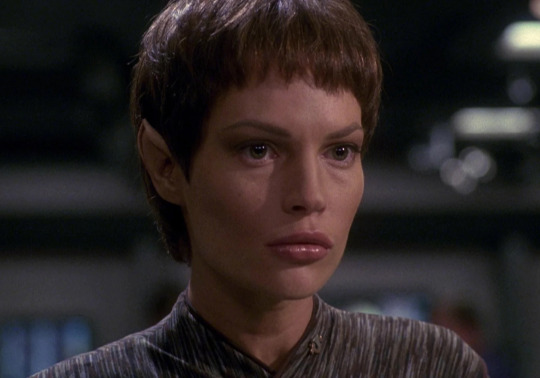
5. T’Pol - Vulcan first officer from ENT
I am not a fan of Star Trek: Enterprise and I am certainly not a fan of T’Pol. But it would be nice to see treatment of this character without a cat suit and without the bigoted, jingoist attitude of ENT. I am here for extremely old and gray statesman T’Pol.
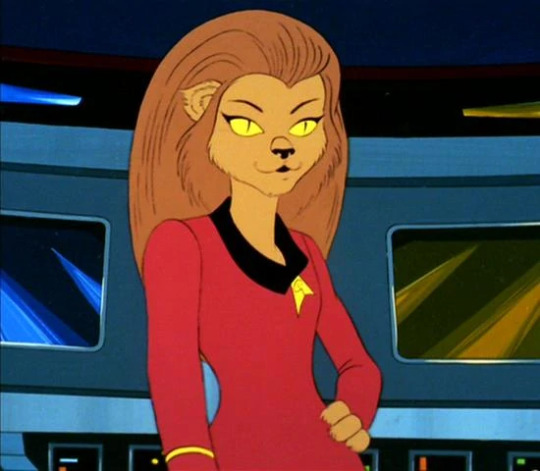
4. M’Ress - officer from The Animated Series
It’s not wrong that I just want live action cat people that are not the movie Cats. I think it would be very cool if she was a cadet and friends with Uhura.
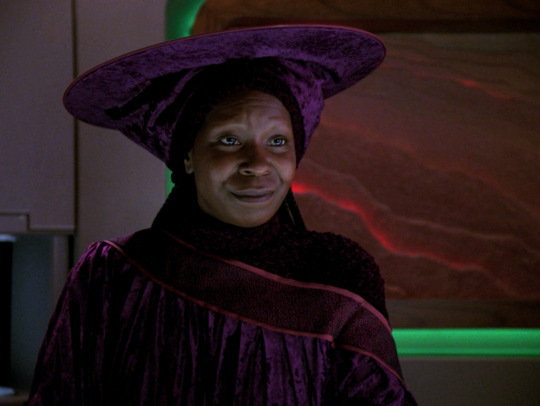
3. Guinan - bartender on TNG
Guinan is old as fuck and was alive during this era; I don’t care if Goldberg is too old to be younger!Guinan; they can make this work; I believe in them.
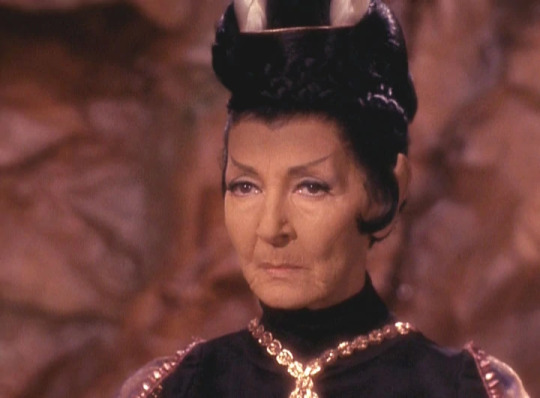
2. T’Pau - Important Vulcan in an episode of TOS as well as several eps of ENT
I fucking love T’Pau and always wished we got more of her being the perfect badass that she is. Maybe we could get the backstory on why she turned down the seat on the Federation Council.
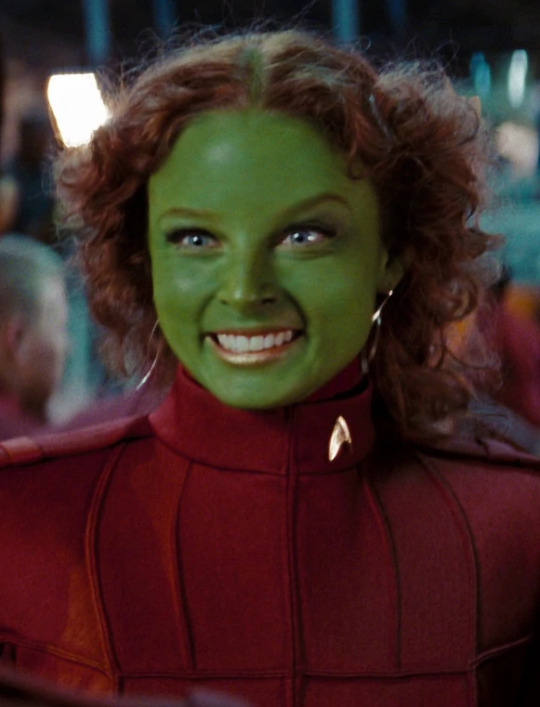
1. Gaila - background character in AOS ‘09
Here we are, the reason I made this post. I’m in love with Gaila. I think she is now my favorite part of the ‘09 movie. I love seeing Orions in Starfleet and I love what fandom did with her--she’s often one of Kirk’s best friends at Academy, and a big damn hero. I would lose my mind if she was on SNW, especially if she was BFF with Kirk aboard the Farragut.
52 notes
·
View notes
Text
Today, the Church remembers St. Augustine of Hippo.
Ora pro nobis.
Saint Augustine of Hippo (13 November 354 – 28 August 430 AD) was a Roman citizen born in the province of Thagaste (in modern Algeria, earlier settled as a Phoenician colony), an early Western Christian theologian and philosopher whose writings influenced the development of Western Christianity and Western philosophy. He was the bishop of the Roman colony of Hippo Regius (modern Algeria), and is viewed as one of the most important Church Fathers in Western Christianity for his writings in the Patristic Era. Among his most important works are The City of God, On Christian Doctrine and Confessions.
His mother, Monica or Monnica, was a devout Christian; his father Patricius was a Pagan who converted to Christianity on his deathbed.
At the age of 11, Augustine was sent to school at Madaurus, a small Numidian city south of Thagaste. There he became familiar with Latin classical literature, as well as pagan beliefs and practices. His first insight into the nature of sin occurred when he and a number of friends stole fruit they did not want from a neighborhood garden. He tells this story in his autobiography, The Confessions. He remembers that he did not steal the fruit because he was hungry, but because "it was not permitted." His very nature, he says, was flawed. 'It was foul, and I loved it. I loved my own error—not that for which I erred, but the error itself." From this incident he concluded the human person is naturally inclined to sin, and in need of the grace of Christ.
At the age of 17, through the generosity of his fellow citizen Romanianus, Augustine went to Carthage to continue his education in rhetoric. It was while he was a student in Carthage that he read Cicero's dialogue Hortensius (now lost), which he described as leaving a lasting impression and sparking his interest in philosophy. Although raised as a Christian, Augustine left the church to follow the Manichaean religion, much to his mother's despair. As a youth Augustine lived a hedonistic lifestyle for a time, associating with young men who boasted of their sexual exploits. The need to gain their acceptance forced inexperienced boys like Augustine to seek or make up stories about sexual experiences. It was during this period that he uttered his famous prayer, "Grant me chastity and continence, but not yet."
At about the age of 17, Augustine began an affair with a young woman in Carthage. Though his mother wanted him to marry a person of his class, the woman remained his lover for over fifteen years and gave birth to his son Adeodatus (b. 372 - d. 388 AD), who was viewed as extremely intelligent by his contemporaries.
Manichaean friends introduced him to the prefect of the City of Rome, Symmachus, who while traveling through Carthage had been asked by the imperial court at Milan to provide a rhetoric professor. Augustine won the job and headed north to take his position in Milan in late 384. Thirty years old, he had won the most visible academic position in the Latin world at a time when such posts gave ready access to political careers.
Although Augustine showed some fervour for Manichaeism, he was never an initiate or "elect", but an "auditor", the lowest level in the sect's hierarchy. While still at Carthage a disappointing meeting with the Manichaean Bishop, Faustus of Mileve, a key exponent of Manichaean theology, started Augustine's scepticism of Manichaeanism. In Rome, he reportedly turned away from Manichaeanism, embracing the scepticism of the New Academy movement. Because of his education, Augustine had great rhetorical prowess and was very knowledgeable of the philosophies behind many faiths.
At Milan, his mother's religiosity, Augustine's own studies in Neoplatonism, and his friend Simplicianus all urged him towards Christianity. Initially Augustine was not strongly influenced by Christianity and its ideologies, but after coming in contact with Ambrose of Milan, Augustine reevaluated himself and was forever changed. Like Augustine, Ambrose was a master of rhetoric, but older and more experienced. Augustine was very much influenced by Ambrose, even more than by his own mother and others he admired. Augustine arrived in Milan and was immediately taken under the wing by Ambrose. Within his Confessions, Augustine states, "That man of God received me as a father would, and welcomed my coming as a good bishop should."
Soon, their relationship grew, as Augustine wrote, "And I began to love him, of course, not at the first as a teacher of the truth, for I had entirely despaired of finding that in thy Church—but as a friendly man." Augustine visited Ambrose in order to see if Ambrose was one of the greatest speakers and rhetoricians in the world. More interested in his speaking skills than the topic of speech, Augustine quickly discovered that Ambrose was a spectacular orator. Eventually, Augustine says that he was spiritually led into the faith of Christianity.
Augustine's mother had followed him to Milan and arranged a marriage for him. Although Augustine accepted this marriage, for which he had to abandon his concubine, he was deeply hurt by the loss of his lover. He wrote, "My mistress being torn from my side as an impediment to my marriage, my heart, which clave to her, was racked, and wounded, and bleeding." Augustine confessed that he was not a lover of wedlock so much as a slave of lust, so he procured another concubine since he had to wait two years until his fiancée came of age. However, his emotional wound was not healed, even began to fester. He later decided to break of his engagement and become a celibate priest.
In late August o of 386 AD at the age of 31, after having heard and been inspired and moved by the story of Ponticianus's and his friends' first reading of the life of Saint Anthony of the Desert, Augustine converted to Christianity. As Augustine later told it, his conversion was prompted by a childlike voice he heard telling him to "take up and read" (Latin: tolle, lege), which he took as a divine command to open the Bible and read the first thing he saw. Augustine read from Paul's Epistle to the Romans – the "Transformation of Believers" section, consisting of chapters 12 to 15 – wherein Paul outlines how the Gospel transforms believers, and the believers' resulting behaviour. The specific part to which Augustine opened his Bible was Romans chapter 13, verses 13 and 14, to wit:
Not in rioting and drunkenness, not in chambering and wantonness, not in strife and envying, but put on the Lord Jesus Christ, and make no provision for the flesh to fulfill the lusts thereof.
He later wrote an account of his conversion – his very transformation, as Paul described – in his Confessions, which has since become a classic of Christian theology and a key text in the history of autobiography. This work is an outpouring of thanksgiving and penitence. Although it is written as an account of his life, the Confessions also talks about the nature of time, causality, free will, and other important philosophical topics. The following is taken from that work:
Late have I loved Thee, O Lord; and behold,
Thou wast within and I without, and there I sought Thee.
Thou wast with me when I was not with Thee.
Thou didst call, and cry, and burst my deafness.
Thou didst gleam, and glow, and dispel my blindness.
Thou didst touch me, and I burned for Thy peace.
For Thyself Thou hast made us,
And restless our hearts until in Thee they find their ease.
Late have I loved Thee, Thou Beauty ever old and ever new.
Ambrose baptized Augustine, along with his son Adeodatus, in Milan on Easter Vigil, April 24–25, 387 AD. A year later, in 388, Augustine completed his apology On the Holiness of the Catholic Church. That year, also, Adeodatus and Augustine returned home to Africa. Augustine's mother Monica died at Ostia, Italy, as they prepared to embark for Africa.
Upon their arrival, they began a life of aristocratic leisure at Augustine's family's property. Soon after, Adeodatus, too, died. Augustine then sold his patrimony and gave the money to the poor. The only thing he kept was the family house, which he converted into a monastic foundation for himself and a group of friends.
In 391 Augustine was ordained a priest in Hippo Regius. He became a famous preacher (more than 350 preserved sermons are believed to be authentic), and was noted for combating the Manichaean religion, to which he had formerly adhered. In 395, he was made coadjutor Bishop of Hippo, and became full Bishop shortly thereafter, hence the name "Augustine of Hippo"; and he gave his property to the church of Thagaste. He remained in that position until his death in 430. He wrote his autobiographical Confessions in 397–398. His work The City of God was written to console his fellow Christians shortly after the Visigoths had sacked Rome in 410 AD.
When the Western Roman Empire began to disintegrate, Augustine imagined the Church as a spiritual City of God, distinct from the material Earthly City. His thoughts profoundly influenced the medieval worldview. The segment of the Church that adhered to the concept of the Trinity as defined by the Council of Nicaea and the Council of Constantinople closely identified with Augustine's On the Trinity.
Augustine worked tirelessly in trying to convince the people of Hippo to convert to Christianity. Though he had left his monastery, he continued to lead a monastic life in the episcopal residence. He left a regula for his monastery that led to his designation as the "patron saint of regular clergy".
Much of Augustine's later life was recorded by his friend Possidius, bishop of Calama, in his Sancti Augustini Vita. Possidius admired Augustine as a man of powerful intellect and a stirring orator who took every opportunity to defend Christianity against its detractors. Possidius also described Augustine's personal traits in detail, drawing a portrait of a man who ate sparingly, worked tirelessly, despised gossip, shunned the temptations of the flesh, and exercised prudence in the financial stewardship of his see.
Shortly before Augustine's death, the Vandals, a Germanic tribe that had converted to Arianism, invaded Roman Africa (and later sacked Rome in 455 AD, hence the term vandalism). The Vandals besieged Hippo in the spring of 430 AD, when Augustine entered his final illness. According to Possidius, one of the few miracles attributed to Augustine, the healing of an ill man, took place during the siege. According to Possidius, Augustine spent his final days in prayer and repentance, requesting that the penitential Psalms of David be hung on his walls so that he could read them. He directed that the library of the church in Hippo and all the books therein should be carefully preserved. He died on 28 August 430 AD. Shortly after his death, the Vandals lifted the siege of Hippo, but they returned not long thereafter and burned the city. They destroyed all of it but Augustine's cathedral and library, which they left untouched.
Augustine was canonized by popular acclaim, and later recognized as a Doctor of the Church in 1298 by Pope Boniface VIII. His feast day is 28 August, the day on which he died.
Augustine is recognized as a saint in the Catholic Church, the Eastern Churches, and the Anglican Communion and as a preeminent Doctor of the Church. He is also the patron of the Augustinians, a religious order. His memorial is celebrated on 28 August, the day of his death.
Many Protestants, especially Calvinists and Lutherans, consider him to be one of the theological fathers of the Protestant Reformation due to his teachings on salvation and divine grace. Protestant Reformers generally, and Martin Luther in particular, held Augustine in preeminence among early Church Fathers. Luther himself was, from 1505 to 1521, a member of the Order of the Augustinian Eremites.
In the East, his teachings are more disputed, and were notably attacked by John Romanides. But other theologians and figures of the Eastern Orthodox Church have shown significant appropriation of his writings, chiefly Georges Florovsky. The most controversial doctrine associated with him, the filioque, was rejected by the Orthodox Church. Other disputed teachings include his views on original sin, the doctrine of grace, and predestination. Nevertheless, though considered to be mistaken on some points, he is still considered a saint, and has even had influence on some Eastern Church Fathers, most notably Saint Gregory Palamas. In the Orthodox Church his feast day is celebrated on 15 June.
Historian Diarmaid MacCulloch has written: "[Augustine's] impact on Western Christian thought can hardly be overstated; only his beloved example Paul of Tarsus, has been more influential, and Westerners have generally seen Paul through Augustine's eyes."
Lord God, the light of the minds that know you, the life of the souls that love you, and the strength of the hearts that serve you: Help us, following the example of your servant Augustine of Hippo, so to know you that we may truly love you, and so to love you that we may fully serve you, whom to serve is perfect freedom; through Jesus Christ our Lord, who lives and reigns with you and the Holy Spirit, one God, now and for ever.
Amen.

#christianity#jesus#god#holy trinity#theology#father troy beecham#troy beecham episcopal#father troy beecham episcopal#saints
11 notes
·
View notes
Text
update: August 2020, part 4
part one | part two | part three
Welp, after having some $%#@*&@!!! computer problems and being bogged down by work, I’m back to harass you with the last of this...um...this interval of an indeterminate period of time’s update! 😁
(Psst.. Please thank @chiaroscuroverse for the fic bonanza in the AU department!)
fic rec list masterpost
💘 = adult rating (For longer fics, this likely only applies to some chapters.)
EPISODES
Added to Episodes: The Idiot’s Lantern
Reassurance by @gallifrey1sburning (ficlet, all ages)
Sight by BadWolf256 (short story, teen)
Added to Episodes: Impossible Planet/Satan Pit
Battle by Rynne (short story, teen)
Letting Go by Vanderslice (ficlet, teen)
Added to Episodes Beyond Rose's Canon Era: Human Nature/FoB
Always Her Doctor by @chocolatequeennk (novella, teen)
Added to FixIts: GitF General
Got to Be There by @davinasgirlfriend (TenxRose, ThirteenxRose, short story)
A Question of Worth by @countessselena (all ages, short story)
Repercussions by littleredkoalabear (teen, short story)
Added to Rose in Series 3 (Series 3 Rewrites)
A Place for Us to Dream by @dimensionhoppingrose (novel, part of series, teen)
To Lead Herself Home by @chocolatequeennk (series, teen)
The Doctor and the Wolf by MerryweatherWho (series, teen)
💘 Touched by an Angel by @lastbluetardis (Blink, short story)
Don't Blink by rosewarren (Blink, novel, teen)
HULLABALOO
Added to Christmas: Misteltoe
Never Been Kissed by @lillibetm3 (Nine)
Added to Christmas: Nine
All I Want for Christmas Is You by @lillibetm3 (teen, short story)
Added to Christmas: Ten
Christmas Joy by @chocolatequeennk (short story)
Christmas Tree by @lizann5869 (ficlet)
Added to Christmas: Tentoo
Time Lord Technology and Hidden Depths by @ialwayscomewhenyoucall
AU
Added to General AU: Nine
💘 A Death Defying Romance by @paigenotblank (the Doctor is Death au, short story)
Love Always, The Doctor by @chiaroscuroverse & @fleurdeneuf (EightxRose, NinexRose, novella, teen)
The Time Lord’s Wife by frin tennant (NinexRose, TenxRose, adult, The Time Traveler’s Wife au)
Added to AU: Artist
Fixed Focus by @mariechambers (TenxRose, short story, teen)
Added to AU: Bodyguard
An Unwilling Arrangement by @doctor-who-hears-a-horton (TenxRose, all ages, novella)
Added to AU: Crime
teeth and thorns by @his-braveheart (NinexRose, Black Widow au, short story)
guns and horses by momentmusical (TenxRose, spies, short story)
💘 The Blue Box Case by @kelkat9 (TenxRose, spies, novel)
Take the Money and Run by @gingerteaonthetardis and @lotsofthinkythoughts (EightxRose, crime, novella)
Added to AU: Fairytale
The garden where all beauties be by @gingerteaonthetardis (Nine, short story)
obscured by @perfectlyrose (Nine, novella, wip)
Once upon a time… by @asthewheelwills (Nine, short story)
Red by @badwolfxoncomingstorm (kaynibbler16) (Ten,short story)
Added to AU: Films
The Academy by @kelkat9 (X-Men, Ten, novel)
As The Sun Will Rise by helplesslynerdy (Beauty and the Beast, Ten, series)
💘 Elsewhere by @fadewithfury (Somewhere In Time, Ten, novel)
He Gave Me the World by @buffyann23 (While You Were Sleeping, Ten, novella)
Opening Walls by Toppbanana (Anastasia, Ten, novel)
A Scribble In Time by @deathlyfandoms (Tangled, Ten, novella)
Stars On Her Ceiling by @davinasgirlfriend (The Shape of Water, Ten, novella)
Stowaways by @ofstormsandwolves (Treasure Planet, Ten, novella)
The Time Lord’s Wife by frin tennant (The Time Traveler’s Wife, novella)
Who’s Got Mail by @whoinwhoville (You’ve Got Mail, Ten, novella)
Added to AU: Regency/Historical
the end of east by momentmusical (tenxrose, short story)
💘 Where You Tend a Rose by @illogical-fascinations (tenxrose, novella)
Added to AU: Royalty
kings are cowards by @rose-tylers (onlyeverthus) (Ten, short story)
Once Upon A Time and Far Far Away by WordMusician (Ten, novella)
The Princess, And Him by @doctor-who-hears-a-horton (Ten, novella)
Added to AU: Singer
I Write The Songs by @licieoic (ten, uni au, teen)
💘 The Vortex Boys by @aintfraidanoghosts (ten, novella)
The Lads From Gallifrey by @kelkat9, @whoinwhoville, and timelord1 (nine, ten, eleven, short story, teen)
💘 Air From My Lungs to Give Voice to Your Song by @licieoic (ten, au dark!doctor, warnings)
Added to AU: Single Parent
Electrical Impulses by @asthewheelwills (Nine, novella, all ages, wip)
Love Always, The Doctor by @chiaroscuroverse & @fleurdeneuf (Nine, novella, teen)
Added to AU: School
Ready, Set, Let's Go by @deathlyfandoms
Five times John Smith & Rose Tyler saved each other from getting doused, and one time they didn't by @kilodalton
The Perils of Pink by @deathlyfandoms
In the Rain by @emkaywho
Rooftop Picnics by @perfectlyrose
Running through the High School hallways by @asthewheelwills
With A Little Bit of Luck by @deathlyfandoms
Added to AU: College
PLEASE NOTE: I think something went wrong with this list at some point! I'm sure it is my fault, because I always feel compelled to rewrite the HTML to clean up tumblr being tumblr... (bad codemonkey me!) There seems to be more below than is actually on the list itself! @chiaroscuroverse, let me talk to you about this! I know some of these are also superhero aus. If there are any corrections, I'll post them later.
Catalysis by @lastbluetardis (series)
Constellations of Their Own Making (The Galaxy's Edge Remix) by @sequencefairy (short story)
💘 First year by OiWatchItSpaceman (short story)
Got to Be There by @davinasgirlfriend
Her Guitar Hero by @asthewheelwills (short story)
Match Set by @bluedawn0123 (short story)
Misunderstandings and Reconciliations by @dryadalis (short story)
An Old-Fashioned Correspondence by @deathlyfandoms (short story)
Pins and Needles by @professorspork (short story)
Sweetheart by @stoprobbersfic
Uni Professors AU by @perfectlyrose (NinexRose, ficlet)
Uni-verse by @jellyneau-xo
[ETA: Superheroes]
Girl of Steel by @rosa-acicularis
Hero/Heroine by @chocolatequeennk
Heroes of Tardis City by @timeladyofthesith
In a Single Bound by @allrightfine
Little Secrets by @allrightfine
Super Bad Wolf by @gallifreyburning
Strike of Lightning by @goingtothetardis
80 notes
·
View notes
Text
OC - Jin Windu-Kenobi
Trigger warning: mentions of rape, sexual assault, kidnapping.
Faceclaim: I haven’t found one, but I like to imagine she looks a lot like her mother Helene (Zendaya).

Verse: Star Wars
Era: Originals & The Mandalorian
Occupation: Farmhand (episode iv), rebel (episode iv+), jedi padawan (episode v), attendant at Oran & Sirius Blacksmith (the mandalorian)
Master: Yoda (briefly)
Notable family members: Helene Windu (mother) Obi-wan Kenobi (father) Mace Windu (uncle) Grogu (foster son)
Love interest(s): Luke Skywalker (unrequited until the Mandalorian) Din Djarin
Bio: Jin was born on Tattooine, and raised alone by her mother, Helene. She befriended Luke Skywalker at a young age, and fell in love with him while growing up. Unfortunately for Jin, this love was unrequited as Luke seemed more interested in getting to the pilots academy.
Despite this, Jin followed him wherever he went. When his parents were murdered, Jin followed him and Obi-wan (who she didn’t realise was her father) to save the galaxy. While on the Millenium Falcon, Jin explained to Obi-wan that she always had strange dreams that felt more like visions. He told her he could sense she was very strong with the force. Jin was confused, telling him that her mother never told her she was once a Jedi - so she didn’t believe it. She said she knew nothing of her father only he was a pilot. Obi-wan had promised Helene he would not tell Jin he was her father, so he played along.
After Obi-wan’s death, Jin briefly returned to Tattooine to see her mother, who confessed that Obi-wan was her father. Jin was so upset she left and didn’t return for a very long time, and legally added ‘Kenobi’ to her name.
Jin followed Luke to Dagobah, where they met Yoda. He trained them both for a short period of time, until Luke told them he had a feeling Han and Leia would be hurt. Jin left with him, and Yoda remarked that she was like her mother, running away. Jin did return with Luke to finish her training, and was very upset when Yoda passed away.
Luke promised to train Jin, but before she could, she was kidnapped by ex-stormtroopers as everyone partied on Endor. She was taken to a remote planet, where they were hiding, and sexually assaulted for three years. That is, until an assassin named Oran came to her rescue. He stumbled upon her by accident, alone and afraid - and blind.
Upon further examination by a doctor, it was revealed that Jin had experienced years of sexual abuse, that lead to her going blind. The doctor revealed it was blindness caused by trauma - and that it was possible for Jin to regain her sight in time. Oran took care of her, and tried his best to make Jin feel comfortable enough so her sight would return.
He allowed her to work at his new business - a blacksmiths shop, which she shared with his old apprentice, Sirius. One day, the Mandalorian himself (Din Djarin) was tasked with bringing her in cold by a surviving ex-stormtrooper, who had made it away from Oran that day. However, when he seen how frightened and fragile she was, he felt bad. He was coaxed into taking care of her by Oran, who stayed behind.
Oran was eventually killed by another bounty hunter, and Din caught word of this. He didn’t tell Jin, because she hoped to be reunited with him someday. However, he did eventually tell her, but she was already at peace with never seeing him again.
When they found Grogu, Jin was upset when Din turned him in. Eventually, she comes to think of Grogu as her own baby. Both Din and Jin fall in love with each other, despite the fact that she couldn’t even see him. Eventually, Jin regained her sight after spending time with Din and Grogu, because she finally felt happy for the first time in a long time. At first, her sight was blurry, but over time it became better. When confronted by the stormtrooper that kidnapped her, he sneered that she was clearly in love with Din despite never seeing his face.
Once he killed the ex-trooper, Din told her she isn’t stupid - and that he appreciated her loving him for him. So, he removed his helmet. Jin refused to open her eyes, not wanting to see his face, because “that’s not the way.” Din begged her to open her eyes, and she did, finally getting to kiss him for the first time.
#star wars character#star wars fanfic#star wars roleplay#star wars oc#the mandalorian#the mandalorian oc#din djarin
1 note
·
View note
Text

Something I want to delve into in the story is temporal mechanics and time travel.
In the Raildex Universe/the Prime Universe of the Kinoverse, there are no branching timelines that lead to other realities. In the Kinoverse, each universe is radically different from one another in some way, shape or form, from Earth being given different names and entirely alien geography, to differing laws of physics and elements like Magic and Scientific formulas. What I’m going to discuss however is not the Multi-Universe, but rather the singular timeline that Prime Earth is confined to.
In the Index novels, it’s explained that there are no paralell worlds as it relates to temporal mechanics, meaning that a new timeline simply cannot be branched off from one point in time. The world timeline is described as a a straight line, compared to a rubber string nailed onto a pachinko machine. Like a rubber string and like time or space, the world can stretch or contract. Partially due to this nature, there are a fair number of portions in the world that are unused.
In other words, there is only one timeline, and while time can be altered, it cannot branch off. There are very few supernatural powers which can travel through or manipulate the flow of time; aside from the application of a Magic God's power, and I plan to delve into this.
In the current verse, there are two ways one can travel through time, though both of them have not yet been formally introduced. The first method is through a process called Rayshifting, something that was first introduced in the Genesis Continuity but never properly explained due to the convoluted nature of the Genesis Era as a whole.
The process starts off with the Subject entering something called the Coffin, the Parameters of the rayshift subject will be analyzed and defined , and through the use of magic, the candidate will be in a state of a Schrodinger's Cat (Living but Dead Box), making the subject's life status as "Unknown"
The process of Pseudo Spiritron Dismantlement (Scientific term for the energy given off by a person’s soul) is then initiated and by using all available energy sources in the facility the procedure is taking place, the Coffin calculates and analyzes the Body, the History of the subject, the relations to Causality and etc. The Coffin will then form an imaginary formula to hold up the subject's history in place. Using a supercomputer as a Map of History that can last as much as 100 Years from the present day, the coffin will analyze situation of the era of the Rayshift. And once it is complete, it will engage in Spiritron Projection of the subject. Once the Spirtron of the subject has fully completed the Rayshift, the Coffin will block itself from the outside world. The subject will materialize in the era of the Rayshift. Usually falling from the sky.
The twins known as Sens and Strasse are the children of Accelerator and Violent Violet, who used the Rayshift Process to travel 17-18 years back in time in order to protect their parents from the forces that pose a threat to them and their peace. It is done in order to ensure that their future is maintained, meaning that if they deviate from their actions or something happens, the future could be drastically changed. Since Rayshifting is being used by this point, it can be assumed that Academy City has somehow successfully merged Science and Magic in order to accomplish this, and its most likely not the only thing they have accomplished.
The second one is a bit more mystical in nature and has not yet been introduced in any iteration of the story.
The second method comes in the form of The Phase Between Worlds, a space of some sort that serves as a nexus point for all of time and space. Here, Time and distance is irrelevant as anyone who is able to sucessfully reach this place can have some degree of access to any point in time. Magic Gods have no use for this place, as they already have the power to mess with time and space with the manipulation of Phases, but a human or powerful enough Magician can make use of it.
In this realm, there are various “Gateways” that can show images of places, people and events in different time periods, and others can interact with it, going into a point in the past or future and getting involved with events --- which can be proven to be quite disastrous should anyone misuse it. That’s why it is very difficult to reach this place, and is only seen as a myth. There is a rumor though, that a wise yet powerful being watches over this place, and does not interfere with events, but only watches history unfold. It is unknown if this is a Magic God from the Ancient Past or Ancient Future, or if they are one of the Secret Chiefs --- All that is known is that this being simply exists, and he or she watches.
2 notes
·
View notes
Text
Whenever I discuss Sleeping Beauty with someone who doesn’t share my enthusiasm for Disney, they have an irksome tendency to get it muddled with Snow White; their excuse being “it has the same plot”. I’ll admit, there are some surface similarities that even the most casual viewer can pick up on: a fairytale where a princess is forced into unconsciousness and wakes up with some necking, the comic relief and villain being the most beloved characters, a little frolic in the forest with animals, the antagonist plunging off a cliff, you get the idea. In fact, Sleeping Beauty even reuses some discarded story beats from Snow White, mainly our couple dancing on a cloud and the villain capturing the prince to prevent him from waking his princess. Yet despite that, Snow White and Sleeping Beauty are two wholly different movies shaped by the era and talents of the time.
I’ve discussed how Walt Disney was never one to stick to a repeated formula, no matter how successful it was. He must have noticed the parallels between his first movie and this one, but decided to make one crucial change for Sleeping Beauty that would forever differentiate the two: the look. We all know the traditional Disney house style: round, soft shapes, big eyes; charming as it was and still is, Walt was sick of it after several decades. Meanwhile, artists like Mary Blair and Eyvind Earle were producing gorgeous concept art that rarely made a perfect translation into the Disney house style.
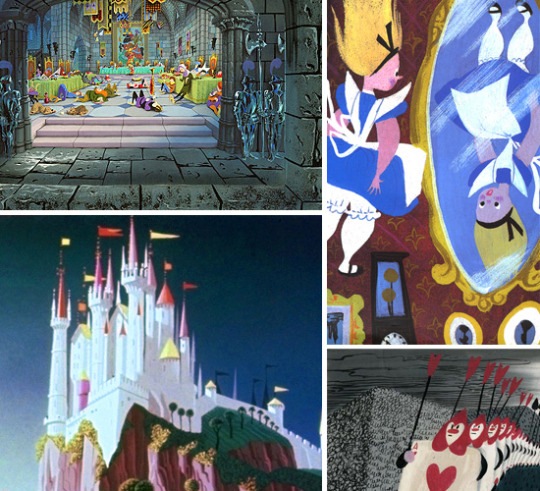
Walt wanted to make a feature that took the pop artistry of their designs and made the animation work for it instead of the other way around – which brings us to another animation studio that was doing well at the time, United Pictures Animation, or UPA.
UPA didn’t have the kind of budget Disney normally had for their animated projects, but what they lacked in fluidity they made up for in style. Watch The Tell-Tale Heart, Gerald McBoing-Boing and Rooty-Toot-Toot to see what I mean. UPA were pioneers of limited animation, taking their scant resources and creating some striking visuals with bold geometric designs. Through this, they defined the look of 50’s animation. Though perhaps unintentional, Sleeping Beauty comes across as Disney’s response to UPA, or what would happen if UPA had the funds they deserved. The characters’ contours are angular but effortlessly graceful, defining their inherent dignity and royalty. And the colors, ohhh the colors…
Because of the immense amount of work required to animate in this difficult new style (and in the Cinemascope ratio, no less) as well as story troubles and Walt barely supervising the animation studio now that he had his hands full with live-action films, television, and a theme park, Sleeping Beauty had a turbulent production that lasted the entirety of the 1950s. For a time, Chuck Jones of Looney Tunes fame was set to direct. Director Wilfred Jackson suffered a heart attack partway through production and Eric Larson, one of the Nine Old Men, took the mantle from there before Walt Disney replaced him Clyde Geronimi. And even after that, Wolfgang Reitherman teamed up with Geronimi as co-director to get the film finished after no less than three delays. Also, Don Bluth got his foot in the door as an assistant animator for this feature, beginning his short-lived but impactful tenure at Disney. Did all this hamper the movie, or did they succeed in what they set out to accomplish?
Well, one of the reasons why this review took so long was because I had a hard time not repeating “MOVIE PRETTY” and “MALEFICENT AWESOME” over and over. Make what you will of that.
The story begins as most fairy tales do with your typical king, Stefan, and his queen suddenly blessed with a baby girl after years of wishing for a child. They christen their daughter Aurora (middle name Borealis, localized entirely within their castle) and throw a huge celebration in her honor. People come from all over the kingdom to pay homage to the princess and OSMKFKSBFHFGILWBHBFC…
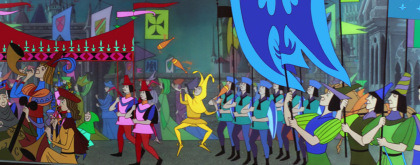
Movie pretty…
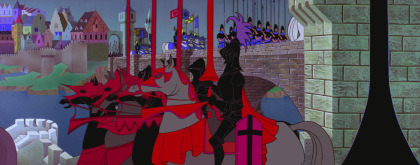
Movie pretty…
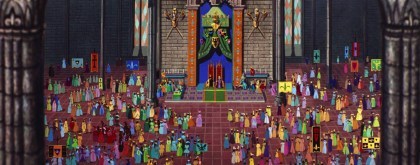
MOVIE PRETTIEEEEEE…
John Hench, Academy Award-winning special effects man and art director, turned Walt on to the idea of basing the look of Sleeping Beauty on classic medieval artwork. Thanks to him and Eyvind Earle’s insanely detailed designs and backgrounds, this is one of Disney’s most visually distinct and beautiful films. A single still from this feature wouldn’t feel out of place up in The Cloisters.
Among the party guests is King Stefan’s old friend King Hubert (Bill Thompson) bringing his young son Prince Philip. Stefan and Hubert wish to unite their two kingdoms and formally announce Philip’s betrothal to the infant Aurora.
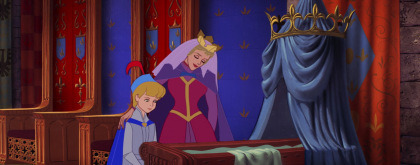
“We were going to do it during the second trimester, but we decided to wait until she was more mature.”
By the way, your eyes are not deceiving you. That is Aurora’s mother, Queen Leah, alive and well and named. And frabjous day calloo callay, she even gets some lines! The most common joke about Disney princesses is that they don’t have moms (even Ralph Breaks The Internet went out of its way to highlight that), so as a hardcore Disney fan who often has to put up with this generalization, Leah’s existence leaves me feeling vindicated.
Once that happy revelation is out of the way, we’re introduced to our main protagonists.
Oh, you thought I was referring to Philip and Aurora? Nonononono, my friends. THESE are the true heroes of Sleeping Beauty, the Three Good Fairies.
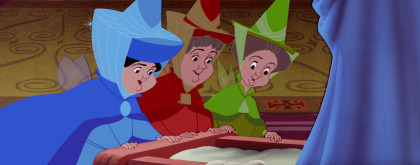
The fairies started off as one-note side characters sharing the same personality. Think pre-Ducktales-reboot Huey, Dewey, and Louie in dresses. But the studio had a difficult time giving Aurora more depth and was having a lot more fun developing the fairies. Naturally, they became so fascinating and appealing that more screentime was given over to them. Now the story’s carried by three wonderfully fleshed out ladies who are distinct in both looks and personality: Flora’s the pragmatic tradition-adhering leader, Fauna’s the sweet scatterbrain who mediates, and Merryweather’s the feisty young upstart.
With the plot now focused on characters who held a traditionally minor role, it’s easy to read this as a perspective-flipped version of the fairytale, but there’s more to it than that. Remember in my Clash of the Titans review how I mentioned the gods literally play chess using the heroes as pieces? I tend to view the main conflict of Sleeping Beauty in the same way. The Three Fairies and Maleficent are in a constant game of good vs. evil, moving Aurora, Philip, and the rest of the royals as pawns in their plans. There’s plenty of plotting and intrigue, with both sides constantly guessing and second-guessing the other’s next maneuver, and even if you’re already familiar with the story’s trajectory you’re still left on the edge of your seat as it inches towards the fiery climax.
And dare I say it but…the fairies and their power dynamic make this Disney’s most feminist film. Yes, really. You could argue that some of the other animated movies from the Renaissance and Revival period have more notable, stronger female protagonists, and many of the live-action remakes try to be woke without really grasping the concept, but consider this: The cast of Sleeping Beauty is mostly female, the leads aren’t objectified in any manner (that is if you count Aurora as a supporting character), nor does their gender factor into their competency, each one differs in age and body type, and most of them are working together towards a common goal as opposed to against each other. Name a movie in the past decade that does the same and still manages to be entertaining (no, really, I’d love to see it). There’s even one scene that unintentionally provides great commentary on the divides in the feminist movement, but more on that later.
Flora and Fauna bless the baby with beauty and song respectively which are accompanied by a short chorus and some sumptuous graphics. I don’t think I need to reiterate that when this movie goes extra with the visuals, it GOES EXTRA with the visuals. Next comes Merryweather with her gift. To this day, no one knows what Merryweather intended to give Aurora. Flora’s the most traditionally feminine of the three so her giving Aurora beauty comes as no surprise. By comparison, Merryweather is the most forward (or unconventional, depending on your point of view). I wouldn’t put it past her to favor Aurora with intelligence, or humor, or passion, or creativity or humility or confidence or decisiveness or physical fitness or great swordsmanship or telekinesis or ice powers or one million YouTube subscribers or comfort in her female sexuality.
Me personally, I think I’ve got the best gift of all:
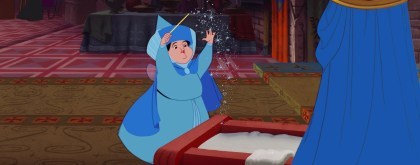
“O Princess, my gift shall be…getting all reviews posted on time for once!”
Alas, before Merryweather can bestow such a wondrous quality upon the child, she’s interrupted by a horny party crasher.
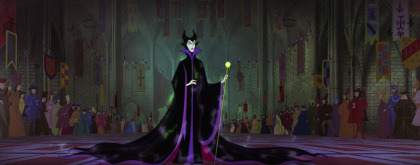
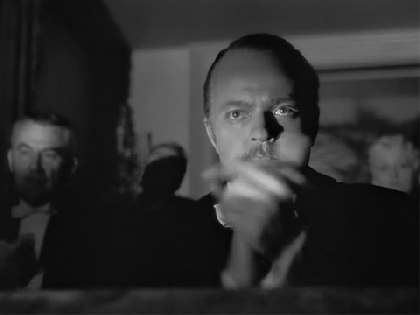
Maleficent. The Mistress of All Evil. Chernabog’s right-hand witch. The Disney villain all Disney villains strive to be. She has it all – the looks, the poise, the power, the laugh, the cunning, the ruthlessness! She doesn’t even need to sing a song because she’s already awesome enough without one. Marc Davis’ gothic design cuts a fine figure and Eleanor Audley’s subtle icy voicework is trés magnifique. As much as I enjoy Audley as Cinderella’s evil stepmother, Lady Tremaine was but an appetizer in comparison to the four-course banquet of pure villainy that is Maleficent.
This leads to a small point of contention some viewers have with Maleficent in spite of hitting top marks elsewhere: her motivation. Putting a hit out on a child for not getting invited to a measly party? Not exactly compelling, is it? And yes, it isn’t a deep motive…is what I would say if I wasn’t well-versed in folkloric tradition. In the original fairy tale and the movie (though it isn’t outright stated in the latter), the party for Aurora isn’t just your average royal kegger, it’s a christening. Back in ye olden days, christenings were very big deals. To not receive an invitation to one was a grave insult, so not extending an invite to your semi-omnipotent magical neighbor is just asking for trouble. In the fairy tale’s defense, no one had seen the evil fairy for years and assumed she was dead, though I can’t imagine how nobody thought Maleficent wouldn’t find about it eventually.
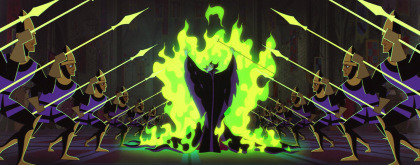
“You dare to deny me, foolish mortals? Very well, then! I shall have my own christening! With blackjack! And strumpets!”
Maleficent is proof that sometimes you don’t have to have an elaborate backstory, a god complex, a tragic past or the unfortunate luck to be on the wrong side of a conflict. Sometimes all you need is some magic, brains, class, and a whole lot of flair to be a perfect, intimidating, and unquestionably iconic villain.
Basically what I’m saying is these movies never happened. Got it?
Maleficent is disarmingly polite over being snubbed, even after Merryweather bluntly tells her nobody wanted her to come. She even brought her own gift for the baby – sixteen years of life cut short by the prick of a spinning wheel spindle, because why change into a dragon and destroy everyone all at once when you can draw the torture out over an agonizingly long time and deliver the coup de grace in the prime of a young woman’s life? That’s how Maleficent rolls, baby. She could dole out capital punishment when she has to without batting an eyelid, but causing human suffering is her bread and butter.
Stefan begs the fairies to undo Maleficent’s curse, but it’s too strong for them. Flora and Fauna insist, however, that Merryweather can use her gift to lessen the spell’s potency. Now instead of dying from that fatal prick, Aurora will sleep until she receives True Love’s Kiss™. Stefan’s not one to throw caution to the wind though, so he orders all of the kingdom’s spinning wheels to be burned in the meantime.
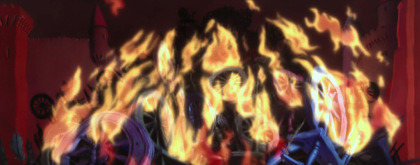
I just pray his kingdom’s economy wasn’t based on textiles otherwise they’re screwed.
As the peasantry celebrates Guy Fawkes Day several centuries early, the fairies ponder their next move. They’ve been around long enough to know that removing spinning wheels from the equation won’t put a damper on Maleficent’s scheme. This scene is incredibly effective in establishing two things:
Maleficent’s near-omniscient presence in the film
How well the fairies’ differing personalities play off each other
Maleficent rarely miscalculates her opponents, and that guile puts her one step ahead of the heroes, making her one of the few Disney villains to nearly reach their goal. The only mistake she makes in the entire movie is trusting her henchmen to do their jobs when she isn’t directly supervising them, though that’s more on them than her. The different methods the fairies propose to deal with Maleficent fantastically illustrate what kind of people they are. Fauna believes she’s just a miserable soul who could be reasoned with if they talk things over. Merryweather would rather take the fight to Maleficent and turn her into a toad. Flora, however, is wise enough to know Maleficent’s too wicked to plead to, too clever to bargain with and too strong to face head-on, so their best course of action is to focus on protecting Aurora through any means necessary. Her initial idea is to enchant the princess into a flower (her namesake is her specialty, after all), but Merryweather reminds her that Maleficent enjoys creating bitter frosts just to kill her flowers.

“Well we could try that but stick her in a castle with a beast for a while…nah, that’ll never work.”
Yet never one to give up, Flora alters the plan so they’ll raise Aurora as a peasant girl out in the woods. This means disguising themselves as humans and giving up magic for sixteen years so as to not attract Maleficent, but that amount of time is like twenty minutes to the fair folk. Stefan and Leah reluctantly agree to the plan, and the fairies spirit little Aurora away from the castle that very night.
Sixteen years later, Maleficent is infuriated that her minions have failed to locate Aurora, even more so when one reveals that they’ve spent the whole time looking for a baby instead of a maturing woman. In an interview with the Rotoscopers podcast, Don Bluth called Maleficent a very flat antagonist because she surrounds lackeys dumber than her so she could be the smart one among them and, again, her supposed lack of motivation. But come on, let’s not entirely condemn the bad guys for having too much faith in their underlings. It’s difficult to find minions smart enough to carry out orders but dumb enough to stay unquestioningly loyal. Usually you have to register as Republican in order to get some.
Maleficent gets her anger out in the most therapeutic way – throwing lightning bolts at her orcs, awesome – then leaves the job of finding Aurora up to her trusty raven Diablo. We then finally see the grown-up Aurora herself, whom the fairies renamed Briar Rose as a nod to the Brothers Grimm version of this tale.
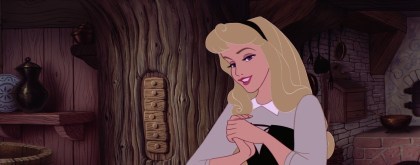
I know I’ve made the occasional case for the princesses from Walt’s era compared to the present day, and yet I have a hard time defending how…I don’t want to say bland. Bland would mean there’s nothing interesting about Aurora, and that’s a lie. She’s gorgeously designed and drawn, and even in her peasant dress she has an air of elegance and sophistication. She carries herself like a queen; her innate royalty reveals itself in her graceful movements. Mary Costa also gifts her with an excellent set of pipes. Hearing her song echoing through the forest is nothing short of magical. She’s a flower child who can talk to animals. She has dreams of escaping her adopted aunts’ loving but stifling care and being allowed to grow up, see the world, actually talk to people, and even find a life partner. She has some strong potential. It’s not that Aurora’s boring, she’s just not quite as developed as we’ve come to expect our animated female protagonists to be. I’m grateful for what we’ve got, but I only wish we could have more. What was her childhood like? How did she learn to communicate with animals? When did the fairies trust her enough to let her spend time out on her own? Did the fairies ever subtly teach her lessons in royalty through lessons and games? Heck, nobody bothers to keep her informed about Maleficent or her curse, and they act surprised when she’s shocked to learn she was a princess the whole time. I want to see what Aurora could have been like if she had known the truth already and what kind of steps she would take to defend herself. Blame the source material for this; it’s difficult to write a compelling main character when she’s supposed to sleep through most of her story.
The fairies send Aurora on a fetch quest so they can plan a surprise birthday party for her. Merryweather wants to bring their magic wands back out for the job, but Flora insists on taking no chances now that they’re in the home stretch. Fauna gets to live her dream of baking an elaborate cake (it’s thanks to her referring to a teaspoon as a “tsp” that I do it too), and Flora insists on making Aurora a gown fit for a princess using Merryweather as a dummy. And we also get one of the best burns in the Disney canon:
Merryweather: It looks awful! Flora: That’s because it’s on you, dear.
youtube
The fairies fall into reminiscing over raising Aurora and get teary over having to let her go soon. I see where they’re coming from, they’re the ones who raised her for sixteen years. They must have so many fond memories, not to mention they put all that work into learning to properly raise a child let alone live like normal human beings seeing how two of them still can’t sew or cook without magic. I wonder what that was like –
No, NO, you CGI abominations DO NOT exist! Go back to the fires from whence you came!!
“Ugh, I’m gonna need something strong to expunge that from my eyes.”
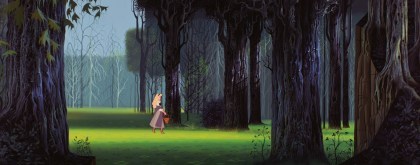
There we go.
Aurora wanders through the forest, drawing out the usual bevy of cute woodland critters with her singing. She also catches the attention of a grown-up Prince Philip (Billy Shirley) who’s more dashing and considerably less blonde than he was sixteen years ago.
By this point, the Disney animators were far more confident in their ability to draw realistic but expressive leading men, hence Philip’s expanded role from the story. He’s also the first Disney prince to have a personality; not a terribly deep or defined one, but it’s a step up from his nameless plot-device predecessors. There are some signs of him being a hopeless romantic, he gets a few funny lines here and there, has a sturdy friendship with his horse Samson, and is fiercely determined when it’s time to kick some ass. He does have the same problem as Aurora in he randomly decides to stop talking for the rest of the movie once he reaches the midway mark (at least Aurora has the excuse that she’s sleeping for that remainder), but I suppose you could chalk this up as to him wanting to spite Maleficent with his silence.
The animals steal some of Philip’s clothes so they can pretend to be Aurora’s dream prince. Aurora plays along as she sings the movie’s standout song, “Once Upon a Dream”. Philip and Samson watch until he smooths his way into the dance. Once Aurora discovers the switch, Philip gets a little too up in her personal space for my liking, constantly grabbing her hand so she doesn’t run off and pulling her closer to him. Not as horrible as what the prince does to the sleeping princess in the original story (a questionably consensual kiss is a trifle compared to how the scumbag of a prince treats her there), but still a bit iffy.
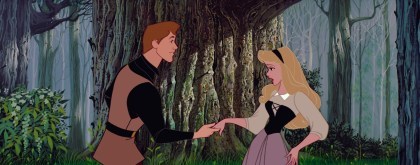
“It’s a good thing my aunts taught me to never go anywhere without a loaded pistol taped to my back.”
But once Philip backs off a little and joins in her song, they both dance together and OEHSGBJSGBLL…

I think I’m going to need surgery to get my jaw off the floor back into its proper place thanks to this movie.
As per Disney tradition, Aurora and Philip’s waltz means the two are head over heels in love with each other. But when it comes time to finally exchange names, Aurora panics and runs away, though she sticks around long enough to tell Philip to meet her family at the cottage that evening.
Back at home, the party preparations aren’t proceeding as planned. Flora’s dress looks as good as my attempts at dressmaking, and Fauna’s dessert wouldn’t feel out of place on Cake Wrecks.
A fed-up Merryweather reads Flora and Fauna the riot act and convinces them to finally take up their wands again. This produces more desirable results, though Merryweather still gets stuck with cleanup duty.
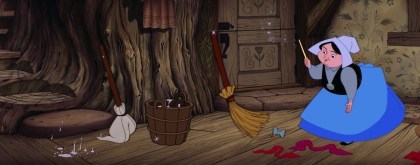
Enchanting a broom to come to life and do your dirty work? I don’t see this going wrong in any possible way.
Things start to go south when Flora and Merryweather argue over the dress color and it escalates into a full-blown wizard’s duel. This gag was supposedly based on the animators’ arguments over what was Aurora’s proper dress color. I think they should have compromised and combined both colors to make purple, which would go lovely with Aurora’s violet eyes, but what do I know. I’m just the illustration major writing a blog. Unfortunately, while the fairies remembered to cover every door, window, and crack that could expose their magic, they overlooked the fireplace. The sparkly residue of Flora and Merryweather’s fight fly up the chimney, alerting Diablo to their hideaway.
Going back to what I said earlier about this movie providing some commentary on feminism, consider this: Flora is obsessed with pink, a traditionally female color, and she gives Aurora an attribute that is oft preferred in a woman but not the most important quality, beauty. Merryweather, on the other hand, is all about blue, a color usually geared towards boys, and she has much more common sense and practicality about her. Though Merryweather and Flora are able to put aside their differences in personalities and approaches for a common goal, it’s when they refuse to compromise and begin prioritizing which color – ie. which ideology and extension of themselves – that they want Aurora to step into that they lose sight of what’s important, and allow everything they worked for to collapse on itself. It’s played for laughs very well, sure, but if not’s symbolic of the dichotomy between traditional femininity and modern sensibility that tears apart the feminist movement then I don’t know what is.
The fairies manage to fix their messes in time for Aurora’s return. She’s thrilled with their gifts but shocks them all when she announces her new boyfriend is coming over for dinner. They come clean about her heritage and betrothal to Prince Philip, and Aurora runs up to her room in tears over the fact that she’ll never see her one true love again. That and her entire life has been a lie and she’s being carted off to meet parents she knows nothing about to marry a man she’s never met and rule an entire kingdom with no prior experience or knowledge. But mostly the true love thing.
Meanwhile, Stefan and Hubert are making wedding plans over wine with “Skumps”, the preferred toast between me and my friends. Also adding to the humor is a minstrel who keeps stealing sips until he literally drinks himself under the table.
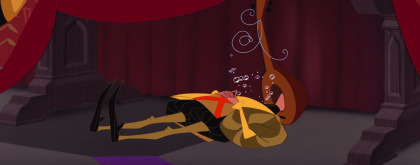
This was also his way of getting through the Black Plague, co-opted by the rest of the world six hundred years later.
Philip returns and Hubert goes to greet him. He thinks his son is thrilled at the prospect of marrying Aurora but is disappointed to learn that he’s fallen for an anonymous peasant.
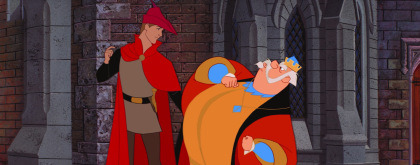
“At least tell me if she’s royalty in disguise so you don’t elope to Sicily!”
Philip rides back into the woods for his big date, leaving Hubert with the unenviable task of breaking the bad news to Stefan. As for Aurora, the fairies smuggle her into the castle and prep her for her homecoming. She’s still blue over having to ghost her forest hubby though, so the fairies give her some time to herself.
Biiiiiiiiig mistake.
So imagine you’re me, growing up watching this movie on tape on a television set with a very standard but not spectacular sound system. Then years later you download the remastered soundtrack and give it a listen while you’re falling asleep. You’ve got the whole score memorized, the volume is nice and low, it’s all good.
And then, just as you’re drifting off, you hear a ghostly voice singing in your ear “Auroraaa…Auroraaaaa…”

That reminds me, I haven’t had a chance to talk about the music yet, haven’t I? Forgive me for waiting so long to do so but my reaction to it is equivalent to the visuals. The score is taken straight from the Sleeping Beauty ballet by Tchaikovsky, the same composer as The Nutcracker, and it is lush, sweeping, sumptuous, just…

While George Bruns was mostly faithful with how the score was represented within the context of the ballet, at certain points he took the same approach as The Nutcracker Prince and rearranged the music order to underscore totally different scenes to staggering effect. The beautifully ominous music where Maleficent appears as a ball of green flame and leads the hypnotized Aurora to her doom? It’s from one of the ballet’s divertissements where Puss in Boots dances with his girlfriend. But tell me which is more fitting for a musical composition such as this – two cats pirouetting around each other in a crowded ballroom, or eerie pitch-black spiral staircases illuminated by green fire as a cursed princess inches closer to her dark destiny against her will?
youtube
The fairies realize their error and frantically search the maze of secret passages for Aurora. Though the princess resists Maleficent’s commands for only a moment, they are still too late to save her from fulfilling the curse. Maleficent gloats and leaves the fairies to wallow in their failure. It’s made even worse as the merrymaking from the oblivious revelers below ring out while they put Aurora to bed in a tower and mourn over her. It’s heartbreaking: they raised and loved her as if she were their own daughter, and they still couldn’t protect her. Everyone talks about “Baby Mine” and Bambi’s mom as huge tearjerkers, but why is this scene constantly forgotten?

Stupid onions, stupid stupid onions…
Fauna and Merryweather can’t even begin to imagine how heartbroken Stefan and Leah will be, but Flora has a solution: put the kingdom to sleep along with Aurora until she is woken up. I understand her wanting to spare Aurora’s family some pain, but conking out an entire principality for god knows how long to cover up their failure? AND at a time when Europe was all about invading and conquering itself? Are we sure this isn’t just part of Maleficent’s overarching plan for revenge? This sounds more like something she would come up with instead of the leader of the good guys.

“So what happens if one of the neighboring kingdoms decides to attack while everyone’s sleeping?”
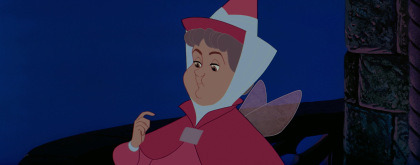
“Then we’ll put them and their armies to sleep, too.”

“And once Aurora is saved, both kingdoms will immediately wake up to find themselves thrust into a war they’re barely prepared for, is that correct?”

“Oh, you’re right, that’s a terrible idea.”

“Finally, thank you.”

“I’ll just turn them all into flowers.”

“THAT’S NOT AN OPTION!!!”
The fairies flitter about the castle grounds spreading their spell over the unwitting royal court, even putting the candles and sconces out. We have another reprise of the “Gifts of Beauty and Song” chorus now altered to sound like a lullaby, providing an interesting bit of symmetry between it and its earlier use in the film. Whereas it first underscored their blessings upon Aurora, now it plays as the fairies are giving the “gift” of sleep to the entire castle.
While Flora knocks out the throne room, she overhears Hubert muttering about Philip eloping with a peasant girl and she makes the connection. The fairies speed to the cottage just as Philip arrives there. But once again Maleficent beats them to the punch. Her goons ambush Philip and she watches them wrestle and bond him with fiendish glee.
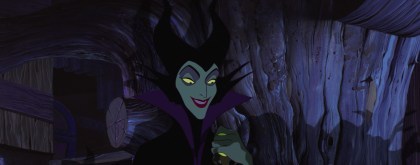
You magnificent, kinky bitch.
Maleficent was only out to capture the one man who could break Aurora’s curse; the fact that he’s really the son of her nemesis’ allies is just icing on the cake. Flora, Fauna, and Merryweather resolve to rescue him from Maleficent’s fortress in the Forbidden Mountain.
Some movies reach the brink of greatness only to falter when it comes to the final act. Sleeping Beauty is not one of them. Everything that happens from the moment we slowly zoom in through the purple mist on to the Forbidden Mountain itself up until the storybook closes is perfection. The perfectly paced action, the animation, the music, Maleficent’s hideaway in all its decaying glory (I swear it’s like Jean Cocteau meets Frank Frazetta meets Giotto) all make for the climax of climaxes.
The fairies shrink to insect size and silently sneak through Maleficent’s creepy domain, narrowly running into guards and gargoyles at every turn. They traverse the stronghold until they find her overseeing a hellish bacchanalia in honor of her supposed victory.
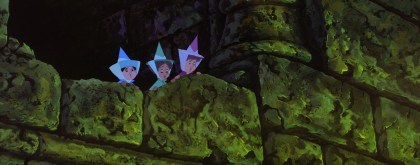
“My old gaffer would have a thing or two to say if he could see us now.”
Soon Maleficent gets bored and goes to “cheer up” her captive. Then we have it: The Moment.
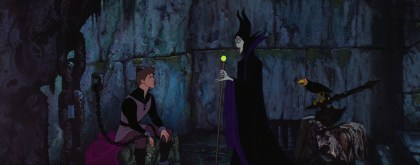
I’ve talked about this before, that one small, devious step further the villain takes to make themselves more heinous in our eyes. It’s the Wicked Witch taunting Dorothy with visions of Aunt Em. It’s the Beldam hanging Other Wybie’s remains. It’s virtually everything Heath Ledger’s Joker does. And it is this simple scene where Maleficent details what she plans to do with Philip. She spins “a charming fairy tale come true” of Aurora sleeping without aging, waiting for her prince to come to wake her. And Philip will escape the dungeon, ride to her rescue and prove true love conquers all – in one hundred years, when he’s a broken old husk of a man on the brink of death. DAMN. If you want to know why Maleficent is considered the best of all the Disney villains, it’s not just all her previously praised qualities, it’s her sheer sadism and the pleasure she takes in it.
The fairies enter and free Philip once Maleficent departs. The course of true love never runs smoothly though, so they arm him with the Shield of Virtue (licensed by Carefree Maxi-Pads), and the Sword of Truth to aid in his escape.
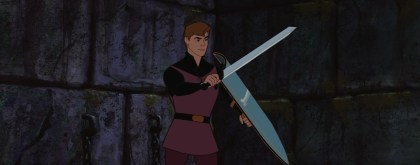
“So, why’s it called the Sword of Truth?”
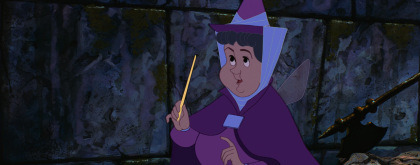
“Anyone who’s subjected to it speaks only the truth…as they bleed out and die, of course.”

“Cool, cool. On an unrelated note, I think I’m gonna go to DC for my honeymoon.”
Diablo sounds the alarm and the Battle With the Forces of Evil kicks off with Philip slashing his Sword of Truth through Maleficent’s goons.

“I steal lunches from the break room fridge!” “I broke wind last Tuesday and blamed it on the dog!” “I cried like a little girl during The Good Place finale!” “I only wash my hands for NINETEEN seconds at a time!”
Philip makes his getaway on Samson and the music reaches truly operatic levels as Maleficent does everything in her power to end him. Yet Philip soldiers through it like a boss. Crumbling mountainsides, Maleficent hurling lightning from the sky and summoning a forest of thorns to block the way? Fuck that shit, he’s gotta go save his girl.
Then, as Philip cuts his way through the briars, Maleficent looks at her watch, realizes it’s No More Fucking Around O’Clock, zooms over to the castle, throws down the most intimidating challenge ever –
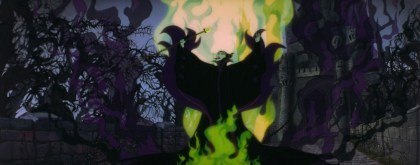
“Now you shall deal with me, O Prince, and all the powers of HELL!!”
– and with that, she takes her final form: a massive fire-breathing dragon.
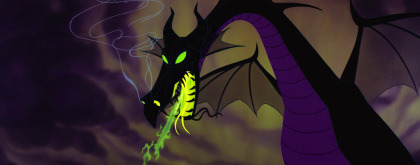

Every Disney villain who’s gone kaiju in the final act owes everything to this gorgeous terrifying beast. The dragon is an awe-inspiring unholy fusion of style, power and darkness. There’s a reason why she’s the final boss in Fantasmic; the chance to watch a live dragon battle is too cool to pass up.
Speaking of battles, Maleficent’s dragon form was animated by Woolie Reitherman, who previously brought us such gargantuan monster clashes as the T-rex brawl in Fantasia and the escape from Monstro The Whale in Pinocchio. And when you have a dragon confronting a fairytale prince, well, you know what’s coming.

Maleficent backs Philip on to a cliff surrounded by flames, leaving him only one desperate shot. With a little extra magic from the fairies, he throws his Sword of Truth at Maleficent and it plunges right into her heart.

“I liked…Frozen 2…more than the first one…”
Maleficent’s spells die with her, clearing the way for Philip. He gives Aurora that wake-up smooch and everyone in the castle slowly rouses, owing their inexplicable simultaneous twenty-minute blackout to the unusually strong wine.
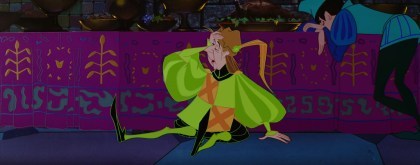
He can attest to that fact.
The royal families are happily reunited, and the film ends on Flora and Merryweather fighting over Aurora’s dress color yet again as she and Philip waltz together on the clouds using animation Beauty and the Beast would borrow thirty-two years later.
Sleeping Beauty is a movie I can never have on in the background because the moment I look up from my work I am spellbound by it. Do I need to elaborate on how this is one of the most beautiful looking and sounding movies Disney’s ever produced? Sleeping Beauty is the swan song of Disney’s first golden age of animation. For better or for worse, their animation process would switch to the rough, cost-cutting Xerox process starting with their next feature, 101 Dalmatians, and few films would reach Sleeping Beauty’s level of gorgeousness ever since.
Though a massive financial and critical hit on release, it wasn’t enough to make up for the monstrous production costs, not unlike Fantasia. Thankfully, home video sales revived interest and made it Sleeping Beauty of the top-selling VHS tapes of the decade, cementing it as a bonafide classic. It’s one of my favorites from Disney for its stunning visuals, gorgeous music, phenomenal villain and overlooked but great cast characters. Revisit it if you haven’t already.
Thank you for reading! If you enjoyed this review, please consider supporting this misfit on Patreon. Patreon supporters receive great perks such as extra votes for movie reviews, movie requests, early sneak-peeks and more! Special thanks to Amelia Jones, Gordhan Rajani and Sam Minden for their contributions!
Artwork by Charles Moss.
Screencaps from animationscreencaps.com
March Review: Sleeping Beauty (1959) Whenever I discuss Sleeping Beauty with someone who doesn't share my enthusiasm for Disney, they have an irksome tendency to get it muddled with Snow White; their excuse being "it has the same plot".
#2D animation#angelina jolie#animated#animated feature#animated movie#animated movie review#animated musical#animation#animator#animators#anthropomorphic animal#aurora#ballet#barbara luddy#battle#battle to end all battles#battle with the forces of evil#bill shirley#bill thompson#blue#briar rose#cake#charles perrault#classic disney#curse#diablo#Disney#disney animated#disney animated feature#disney animated movie
29 notes
·
View notes
Text
@kitsujoo replied to your post:
Maybe bicurious!
@odatodeath replied to your post:
Heteroflexible is a thing that MOSTLY describes that, but saying she is bi with a strong male preference is an option, too... I agree labels are hard tho lol ngdjg
@wingsmashed replied to your post:
Plenty of bi people have preferences for one gender over the other--and usually that attraction feels a little different for each gender? my own attraction to women feels different than my attraction to men.
(( Thank you all for your input ! ^^ I had forgotten about a couple of those labels...and yeah, there are definitely bi people who have preferences for one gender over the other. And I agree —– even though I’m a bi woman who doesn’t have a preference, my feelings of attraction for women definitely feel different than my feelings of attraction for men. XD ))
(( Preferences and types of attraction are something I’ve definitely taken into consideration with my muses I’ve already labeled as bi or pan. Sakon doesn’t have a preference, while Kiyomasa leans towards women but can still feel attracted towards men. Then there’s Katsuie, who can feel attraction to anyone, but who doesn’t feel attracted to someone until he has bonded with them on a really deep level over a fairly long period of time. ))
(( And then there’s the whole —– how well does my muse understand themselves and who they’re attracted to ? For example, my Katsuie has such a HUGE crush on Oichi that he hasn’t even considered anyone else as a partner, man or woman or whoever else, and just assumes that he’s straight (until he meets someone special who doesn’t identify as a woman and figures out that he isn’t straight). And since my muses are at least sort of based in history, there’s also the question of —– how much do the social norms of the time/place impact how well my muses understand who they’re attracted to ? With my portrayal of Sakon/Kiyouki, he pretty firmly identifies as bi in his Sengoku-era verses, but in his modern verse, I feel like he wouldn’t have seen/heard about as many openly gay relationships as in his Sengoku-era verses, so he’s not as sure about who he’s attracted to (hence why I labeled him as questioning in his modern verse). And also, he’s young (15 years old) and frankly not very experienced in his modern verse ! He didn’t have to grow up as fast in a (relatively) safe and stable modern verse compared to his Sengoku-era verses. Fifteen-year-old Modern!Sakon doesn’t have to be anywhere near as responsible for himself as fifteen-year-old Sengoku!Kiyouki has to. And then there’s society’s definition of ‘adulthood’ to think about, too. In his modern verse, Sakon is still considered a kid at 15 years old, but in his Sengoku-era verses (17/18 years old), he’s probably been considered a full-fledged adult for at least a few years. ))
(( Anyways, in regards to Oichi...I’ll think about her some more. ^^ She definitely has a strong preference for men, but she would occasionally feel attracted to a woman...I just need to think about how best to word that. And as for how Oichi would describe her own orientation...I feel like she’d probably consider herself questioning in both her Sengoku-era and modern verses ? Even after marrying/starting to date Nagamasa, Oichi definitely understands that she occasionally has felt / feels something for certain women, but she’d have trouble articulating what exactly that something is, and she just hasn’t interacted with enough people to feel very sure of her orientation. In her Sengoku-era verses, she’s a princess who only leaves the castle to fight for the Oda or Azai, and in her modern verse, she’s a somewhat-sheltered girl from a rich family who doesn’t really interact with other people outside of her own family and students at Basara Academy. Once Modern!Oichi is a little older and has interacted with more people (e.g. once she graduates high school and has gone to college for a couple years), though, I feel like she’d gravitate towards the ‘bi-curious’ label. ))
#(( Wow. I didn't mean to write an essay--but... XD ))#kitsujoo#odatodeath#wingsmashed#OOC#TBD#long post
3 notes
·
View notes
Text

∞Alright, I’m going to write these up before I forget. But there are so many cool AUs/multiverse intersections that I’ve wanted to play around with forever, and I’m going to write up a few in the hopes that someday someone will actually find them in my wishlist tag and geek out with me.
✥ An actual bonafide Captain America: The Winter Soldier era thread. Why, you ask? Because it was easter-egg dropped that Stephen was on Project Insight’s hit list, and that Stephen was a high enough profile target that Sitwell just had him in mind when he rattled off names. At that time Stephen was still a civilian physician (granted his MCU timeline is unclear past 2012 but I maintain that he didn’t go to Kamar Taj until circa 2015/16 which is closer to the Civil War era), so it raises the question of what in his profile constituted threat, AND AND AND - this is the fun part - if Pierce or even Fury at some point might have made a different call and try to strong-arm him into some kind of cooperative arrangement. IDK the possibilities there have always tickled my fancy. ✥ Just a whole bunch of multiverse intersections with the TV shows I geek out over all the time. So The Witcher, The X-Files, Umbrella Academy, James Bond, LOTR, Doctor Who, Star Trek, American Gods, etc. I am such a fucking simp for setting up full-fledged AUs, as well as tossing this wiznerd into sudden dimensional awkwardness because that’s fun too. But honestly I haven’t gotten to really dig in and write an alternate world/verse dependent history for Stephen, and any excuse to is AOK with me. ✥ On that note just more time travel shenanigans? Getting stuck even for short stints in different periods of time is such a kick especially with people who Do Not Want To Be There, because the drama of having to figure out how to eat, how to integrate with unfamiliar social roles, it’s just. So much potential for fun drama. Period AUs are another thing I love playing with because of the aforementioned excuse of writing different back stories.
That’s all for now. I suppose this is just a reminder - if it wasn’t already obvious - that I’m super flexible with plotting and coming up with fun new scenarios even out of standard canon, and if any of y’all ever want to get up to shit 1701/10 I will probably (absolutely) be down for it.∞
4 notes
·
View notes
Text

@cadcnce said: What is one plot/au you want to write?
Send me inboxes about my current interactions (Still accepting!)

I’ll share a few!
- I talked about this a little last week on the blog, but I’d love to write a Non-Despair AU where Sonia’s father passes away early and unexpectedly and she has to assume the throne earlier than she ever expected. This happens in my post-Despair canon, but Sonia is far more prepared(? Sort of?) for this outcome because my HC has her murdering her parents while a Remnant of Despair. So she expects, once she’s told to return to Novoselic, that she has to take the throne as a proper queen this time.
But in this AU? She’s either still in school or just a working royal, still learning the ins and outs of what being a monarch will entail and currying favor with various groups and nations Novoselic needs to remain in the good graces of when her father either dies unexpectedly (war? assassination? Lots of options) or simply early (long-term illness that was hidden from everyone, probably) and she’s got no choice but to become a very young queen, who is instantly feeling more pressure and more overwhelmed than ever before. Admittedly, this probably works best as a ship story, but I’ve never written her with this sort of problem to deal with or cracking under the stress.
- Historical AUs that aren’t medieval and aren’t fantasy/steampunk crossovers. I have a lot of useless knowledge, primarily about the British Royal Family but other European Royals too. I love, LOVE, AUs that allow me to tap into history, anywhere from the mid-16th Century to the early 20th. I’m not really someone who enjoys fantasy elements to my history, so I’d want something that’s a bit more ‘true’ to history I suppose? I’m actually waiting for a mun and their muse to come off hiatus before pitching this again, mostly because their muse is a great fit for a time period I’d love to write, we’ve plotted it somewhat, and I adore their writing. I also have a Code: Realize verse for this, but that’s still more steampunk Victorian than a real Victorian era.
- Talentswap AUs! I have a talentswap for Sonia that I’m pretty much not using at the moment and would love to write with muns who are comfortable/open to the idea. For non-Danganronpa writers/fans, talentswaps are when muses attend Hope’s Peak Academy (the school in the franchise) with talents that aren’t canon to their usual portrayal. For example, Sonia’s talent in game and the DR3 anime is the Ultimate Princess, but my talentswap for her is Ultimate Mafia Boss (which is, actually, different than Kuzuryuu’s Ultimate Yakuza. Before DR fans yell at me, I’ll put that out there right now).
Most/all of the muns I’ve written talentswap with are either on hiatus or permanently gone, which is sad. My talentswap isn’t for everyone (that is, it’s a bit more high stakes than a slice of life student RP or coffee shop AU), but with the right muns who like that sort of content and good muse chemistry? It’s a lot of fun.
For other AUs with questionable/possibly uncomfortable content, I have my Problematic Princess AU (which is basically what happens when a certain part of Sonia’s past, in my headcanon, goes terribly wrong), and...
- Despair-verse. You can’t really avoid the topic in Danganronpa canon unless you’re focusing purely on Non-Despair or Pre-Despair storylines. I’ve hesitated writing too much in this verse, mostly because I really need to trust the mun entirely and plot/run various ideas by them to make sure they’re comfortable with the content at hand. Despair is supposed to be violent and grim, but my Despair!Sonia involves a lot of graphic violence, sex, and gore (she’s a really horrible person as a Remnant of Despair...). And while it would all be tagged and goes under cuts, it’s still unsettling. In short, I’d write this only with someone I could fully trust not to be made uncomfortable by it. Not to mention, I have my own HCs of how Sonia treated some canon characters while in Despair as well.
My other plots/AUs are usually a bit more specific and designed to feature certain characters or character types. But I generally prefer to write Sonia in her older verses and outside of Hope’s Peak when I get the chance, especially crossovers and OCs. I get burnt out on Pre-Despair and Non-Despair school stories with canon muses easily. It’s easier for new mutuals and/or muns new to the franchise and writing DR canon muses, but it’s just hard to come up with new plots after awhile. But give me something outside of Hope’s Peak with a muse that I think might play off Sonia’s personality well (shipping optional but I’ll be the first to admit my weakness for writing them)? I’m probably on board.
#more-than-a-princess answered#more-than-a-princess musings#(Current interactions meme)#cadcnce#(Thanks for the ask!)
3 notes
·
View notes
Text
Meeting The Parents || Avery/Kyosta
@only-somewhat-visible

“I’ll thank you to not insult my blood status again Mr. Vanderbek. I’m not particularly fond of people who do.” Kyosta hated people who looked down on augments. It was hardly their fault that they were simply better than regular humans. They were made that way for Christ’s sakes. Vulcans were and they weren’t hated so much as Kyosta’s people. “And it’d be best if you left my father out of this. The last person who insulted him nearly lost a limb.” That last person was a Klingon but he was hardly going to tell the man that.
Kyosta stood and bent down to kiss Avery on the cheek as he pulled on his jacket. “I’ll see you back at the dorms.” He murmured softly before leaving, cold winter air gusting into the house as he left.
9 notes
·
View notes